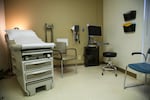The Oregon Health Authority has published new directions for hospitals in the event they need to triage patients and decide who gets urgent, life-saving care in a crisis — and who may not — when there aren’t enough critical resources, such as intensive care beds, available.
Related: Oregon's Crisis Care Triage Algorithm (PDF)
The state health agency promised the guidelines by mid-January as part of the state’s response to the surging omicron variant. State health officials say omicron has the potential to overwhelm a health care system struggling with increased demand and an exhausted workforce two years into the pandemic.
The new triage tool is based in part on updated standards published by Arizona, Massachusetts and Washington.
It directs hospitals to rank patients by evaluating the likelihood of their short-term survival to hospital discharge.
In the event of a tie between two patients who need the same resources, the person already receiving care would continue to get it, unless their condition had worsened.
In ties between two patients with similar conditions presenting at the same time, the triage tool uses randomization to decide who gets care.

File photo: An inside view of one of the exam rooms at Good Samaritan hospital in Northwest Portland.
Alan Sylvestre / OPB
Hospitals can only invoke crisis standards of care and use the triage tool after they’ve exhausted their other options, like transferring patients elsewhere in the state and canceling non-urgent procedures.
“We’re staying hopeful that the scenarios for which this tool would specifically assist — we hope we don’t need to go there,” said Dana Hargunani, Oregon Health Authority chief medical officer.
Hospitals are required to notify the health authority when they are adopting crisis standards of care and to post the information for the public.
In contrast with standards adopted by many other states, Oregon’s standards do not prioritize any particular groups of people for lifesaving care. Other states, for example, award more points to pregnant people, those under 18, health care workers, or single parents.
Hargunani said the triage tool remains an interim document and OHA is open to considering changes in the future, but she said it wasn’t appropriate for the agency to prioritize any group without an adequate public process first.
“We really need to hear from health care providers, from Oregonians about where they would value and prioritize those things for a future tool,” Hargunani said.
The state announced it is recruiting members of a Resource Allocation Advisory Committee to review its crisis standards of care.
During the delta variant surge this summer, health care providers and ethicists warned OHA that the state was dangerously close to a scenario where hospitals couldn’t care for everyone and asked for clearer crisis care guidelines.
The agency had disavowed the state’s previous crisis standards of care after the group Disability Rights Oregon filed a federal civil rights complaint, alleging the standards discriminated against older people, people with disabilities, and people of color.
The prior standards held that, in an emergency, hospitals could categorically exclude some people from critical care, like those with certain stages of cancer or other serious illnesses.
Hargunani said the new tool, while it was developed quickly and without an extensive public process, takes into consideration the concerns raised by the disability rights community.
“This tool does not take into consideration things that would be unfair or inequitable,” she said. “For example, [it’s] really important that these tools and decisions don’t take into consideration judgment about quality of life, or survivability five or ten years out, or just the mere presence of underlying conditions.”
Use of the new tool is not mandatory, and hospitals that have developed their own crisis care triage guidelines can use them, as long as they are consistent with state policy, as well as federal civil rights and anti-discrimination laws.
A statewide forecast currently predicts Oregon’s omicron wave will peak at the end of January with about 1,600 COVID-19 patients hospitalized. That’s more than the highest number during the summer delta wave.
However, hospitals in other places hit earlier by the new coronavirus variant have observed that a smaller proportion of omicron patients require intensive care and ventilators compared to those infected with previous variants.
COVID-19 patients currently occupy 17% of the filled ICU beds statewide. The number of COVID-19 patients in the state’s ICUs has remained relatively flat over the last month, at around 100.
